By Amit Roy
IN HIS just-published diaries, Lionel Barber, who enjoyed a long stint as editor of the Financial Times from 2005 to 2020, has written about three trips to India and meeting some of the country’s most powerful figures, including Narendra Modi.
The first time was in 2013 when Modi was “the firebrand chief minister of Gujarat” and then in 2019, when he was prime minister.
In The Powerful and the Damned: Private Diaries in Turbulent Times (WH Allen; £25), there are also recollections of interviews with Manmohan Singh (“softly spoken Sikh”); finance minister P Chidambaram (“bumptious”); Congress leader Rahul Gandhi (“Modi is a lot sharper”); the “feuding” Ambani brothers, Mukesh and Anil; and the governor of the Reserve Bank of India Raghuram Rajan, a 2010 FT Business Book of the Year winner (“a brilliant academic”).
Right at the start, Barber lists 13 world leaders in his “dramatis personae” in politics – Modi is included along with US president Donald Trump and Russia’s Vladimir Putin.
He sets the scene for his first meeting with Modi in Gandhinagar, Gujarat’s capital city: “The chief minister’s office is cavernous – a giant wooden map of the western trading state hangs over an equally gigantic oblong wooden desk. A portrait of a proud Gujarati lion hangs in the north-west corner of the room.
“Modi is a hard-edged, ambitious man blamed for tolerating, if not inciting, anti- Muslim violence in his home state in 2002. Thousands of people were killed. There’s no point in raising directly the mass killings because he will just turn off.
“So I opt for the beguiling style of David Frost, declaring that the world is waiting – waiting – to see what the self-styled man of action will do once in office.”
Barber adds: “The chief minister talks a great deal about farm reform and raising living standards. He rejects any notion of anti-Muslim sentiment. ‘The government religion is the nation first. The Holy Bible is the constitution.’”
The author should have mentioned that a Special Investigation Team (SIT) appointed by India’s Supreme Court to investigate the killings found no evidence against Modi and gave him a clean chit.
The next time the two men meet is in 2019 when Modi is prime minister: “Narendra Modi’s face is everywhere in India, in newspapers, on television and on social media – a cult of personality in India not seen since Indira Gandhi.
“The prime minister, immaculately attired with an orange kurta and grey trousers matched by a trim white beard, greets me like an old friend. We pose for photographs in his newly refurbished office overlooking a lawn with strutting peacocks.
“Modi has a vision of an urbanised, industrialised and modernised India, but his economic record to date has been patchy. His hard-edged rhetoric on corruption has unnerved the multi-millionaires in Mumbai and dented business confidence. People are afraid, I tell Modi. He smiles grimly. ‘If the sun rises over darkness and people are afraid, it is not the fault of the sun.’
“Modi speaks Hindi rapidly, interspersed with English and piles of statistics such as the length of road and rail track, the number of gas cylinders and toilets delivered to rural areas.
“His answer to my first question about agricultural reform takes the best part of 15 minutes. Every now and then, he stares at me, checking whether I have absorbed his message. The smiles have disappeared.
“On foreign affairs, Modi wants a seat at the top table, alongside China, Russia, Japan and the US. This is the world’s new permanent five, rather than the UN Security Council which includes the UK and France, he suggests (‘That era has gone’). At the recent G-20 meeting, Modi tells me proudly, two separate meetings were held between India, Russia and China, and India, Japan and the US – ‘India was the common factor in both meetings’.
“Mahatma Gandhi once said that ‘India lives in its villages.’ Modi has shifted that narrative to an ‘aspirational nationalism’. He has lit expectations among hundreds of millions, particularly the younger generation; but the transition to a market-based digital economy will inevitably produce winners and losers. That is not something which Indian political culture has ever really embraced.”
Barber ends the section by recalling: “On departure, Modi hands me an envelope and urges me to open it. I assume it’s a copy of the official snapshot on arrival today. In fact, the envelope also contains official photographs of our first meeting in Ahmedabad. A touching memento, but also perhaps a gentle reminder: we have you on our files.”
Barber has another reference to Modi from 2015 when the latter is making his first visit to the UK as the Indian prime minister. Barber talks to David Cameron who arrives late for an interview: “He begins not with Europe but with the visit of Indian prime minister Narendra Modi. Cameron says he can’t quite make him out: Modi talks passionately about economic reform but has spent 41 days out of the country since he was elected 18 months ago in a landslide. Cameron wants a better economic relationship with India. I say the Indians are still chippy about their colonial past and obsessed with China’s rise.”
Barber goes on: “Cameron says they’re more interested in their nuclear neighbour Pakistan, a subject about which the UK knows plenty. When I suggest the UK could improve relations by easing visa restrictions, Cameron pushes back, referring to bogus higher education colleges or job seekers who stay on. ‘We don’t need more taxi drivers,’ he tells me.”
This was the trip when Cameron schmoozed Modi during their joint appearance before a packed Wembley stadium.
Barber also describes a trip to Pakistan in 2010 when he met Salman Taseer, just 11 weeks before the governor of Punjab was assassinated by his own bodyguard; played cricket with Imran Khan, “tall, sinewy and at 57 still strikingly handsome”; and had dinner with president Asif Ali Zardari, “known as Mr Ten Per Cent for his business proclivities”. When the meal is served, Barber notices that “Zardari employs a food taster”.
During the meal, “Zardari either deflects or ignores questions until I press him about Pakistan’s use of Islamist militants in neighbouring Afghanistan as leverage in a future peace settlement. ‘When you wear gold earrings and they are too heavy,’ he says, ‘you take them off.’”
He writes: “Zardari never remotely had that margin of manoeuvre, especially with Pakistan’s armed forces and fearsome intelligence services in the background. He completed his term in 2013 but continued to be dogged by charges of money laundering. He continued to campaign for justice in the case of his wife’s (Benazir Bhutto) murder.”
Barber launched his book last week when he told members of the Foreign Press Association: “Remember when you’re the editor, you’re not friends with these people, you can’t be friends, there has to be some distance. …And the reporters would confirm that I never sought to suppress or interfere with a story where I knew the people.”
The author feels his great achievement was to transform a loss-making newspaper into a “global news organisation” with one million paid subscribers.
He did express concern about the effect of Covid on journalism and how Zoom could “reinforce journalists’ temptation to just sit in front of the screen all day, instead of getting out of the newsroom”.
In his book, Barber includes a great line from the one-time legendary editor of the Washington Post: “Ben Bradlee warned that life after editorship would reveal who one’s real friends are.”












